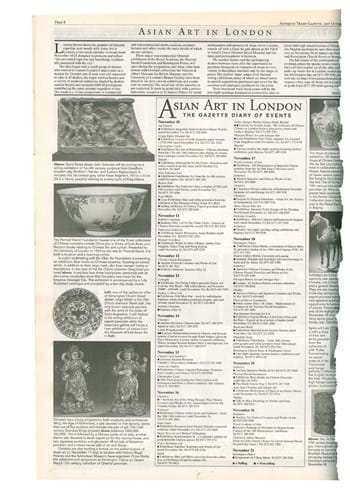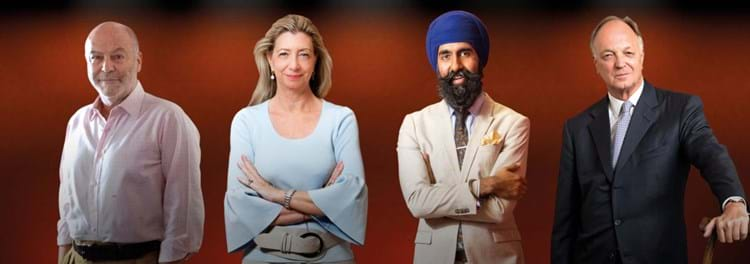It was a provocative article in The New York Times in 1997 – and the indignation of a group of like-minded Mayfair dealers – that led to the creation of Asian Art in London exactly 20 years ago.
Celebrating the launch of a specialist fair in Manhattan, the NYT report described “the eclipse of London” by New York as a leading centre for Asian art and antiques. It was time for some collective marketing.
Rather than mimic what was happening elsewhere, the yearning was for something that would draw attention to London’s unrivalled strength in scholarship and expertise.
“I felt that what made London special was the quality of its dealers – not only the great auction houses – plus the scholars, the shippers, the photographers and the restorers,” recalls sculpture dealer John Eskenazi.
“These people are the backbone of the art trade. So I thought, rather than have a fair, we should encourage collectors to see dealers in their galleries and shops – to see them in the workplace to understand their knowledge, their taste and their personality.”
The event – converging around an array of gallery-selling exhibitions, late-night openings, auctions, receptions, lectures and seminars – was an instant success. “People liked the formula. Moving from one gallery to another, and the cocktail parties. It was a very lively scene,” says Eskenazi.
Back in 1998 AAL was novel in embracing both the academic and commercial worlds and bringing dealers and auctioneers together – at least for a fortnight.
The model, designed to smooth over old rivalries for the greater good, has become a blueprint for similar events in other global selling centres and in other collecting disciplines too.
Despite the changes in the market across almost two decades, AAL chairman Roger Keverne still believes no other city can rival London for the range and depth of its institutional holdings or the expertise of its specialist galleries – or for its ease of doing business.
“Each year AAL reasserts, reemphasises and reminds people, if they needed reminding, of the volume of objects, dealers and expertise in the London market. It also attracts new collectors who know it is a feast of energy, objects and quality that happens just once a year.”

The first Asian Art in London as previewed at the time by Antiques Trade Gazette in 1998. The event included three major museum exhibitions – 100 Masterpieces of Chinese Imperial Ceramics from the Au Bak Ling Collection at the Royal Academy, Rare Marks on Chinese Ceramics at the Percival Davids Foundation and China Mania, a recreation of Queen Mary II’s porcelain display of the 1690s at Kensington Palace.
Tireless interest
Some of the 33 names from the founding event – notably Spink in its guise as an Asian art-dealing powerhouse – are no longer with us.
But the majority are still going strong: senior statesmen of the antiques trade demonstrating a tireless interest in their chosen subject and the addiction to the deal.
The 49 different businesses taking part in the 20th anniversary year include many of those 1998 exhibitors – Roger Keverne, John Eskenazi, Francesca Galloway, Gregg Baker, Ben Janssens, Jacqueline Simcox, Eskenazi and Jorge Welsh all among them.
Others are relative newbies. Arms and armour specialist Peter Finer returns to the fray after joining AAL last year.
“As a newcomer, we expected to meet new collectors and enthusiasts, and I can honestly say we had more visitors to our shop in one week than ever before,” says Red Finer. “We met and did business with a variety of new clients from Hong Kong, China, the US and Britain, some of whom were introduced to our field for the first time.”
Finer’s 18th century lacquered shield from Mysore was a prize-winner – deemed an outstanding object in 2016.
The annual jamborees proved of particular importance for those who do not have a permanent London space. Jacqueline Simcox, the Asian textiles specialist who remembers reading that NYT article with some annoyance, is among them.
“Asian Art in London has always been a marvellous opportunity for me. I already have a good stable of private clients and museums, but you’re always looking for new ones. I don’t have a gallery – people have to make an appointment to see me – so it means I have a central London presence for 10 days.
“Members of the public drop in, which I think is wonderful. A lot of people feel anxious about walking into a gallery because it feels a bit rarefied. But with an exhibition, you can just look around, ask questions, and you don’t feel obliged to buy.”
The overseas contingent
In recent years, overseas exhibitors – necessary to maintain both standards and numbers but also add variety – have been welcomed.
This year they include dealers Genrokuart (Rome and Tokyo) and Guus Röell (Maastricht) plus auctioneers Bruun Rasmussen (Denmark), One East Larasati (Singapore) and Germany’s Lempertz and Nagel.
Six UK auction houses take part – Sotheby’s, Christie’s, Bonhams, Chiswick Auctions, Lyon & Turnbull and Woolley & Wallis – with the usual plethora of complementary events held by regional firms in the autumn months.
The art for sale is just as remarkable in its range. The term Asian art encompasses the artistic endeavour of countless cultures across five millennia. Part of AAL’s appeal has always been its inclusiveness, its love of the interesting, as opposed to the merely expensive. Not everything is five, six or seven figures: there’s wide choice in the hundreds and low thousands.
As the event follows the international market, there has been a strong emphasis on imperial China, but Runjeet Singh, dealer in Asian arms and armour, and board director of AAL, rejects the idea that the event has become too China-centric.
“Middle Eastern, Islamic and Indian [art] is represented very strongly, as is Japanese. Himalayan, Korean and south-east Asian also has several specialists. It is one of my goals as a new director to try and correct this belief and encourage the focus to be shared equally among the Asian cultures.”
The presence of contemporary art at AAL – unthinkable back in 1998 – partly reflects a supply problem but also changing taste and demand. John Eskenazi admits that some dealers “don’t like it”, but he’s not worried about it damaging the brand that places so much stock in scholarship and pedigree. “It’s not always great art,” he says. “It’s mostly just merchandise. But it works. It creates a planetary community of collectors and museums, so why not?”
Design partnership
This year AAL has partnered with the Chelsea Design Centre for the first time, where visitors can view the work of Art in China and Kamal Bakhshi and purchase a limited-edition ‘birthday’ print by the Tibet-born artist Gonkar Gyatso.
Above all, for the 10,000 visitors to the various AAL events, the festival is – as director Virginia Sykes-Wright puts it – “a place to look and learn, and look and buy”.
If anything, the growth of online trading – a seismic change since 1998 – reinforces its raison d’être. The need to touch and feel rather than simply observe (key in this market, perhaps more than any other) has prompted AAL this year to introduce handling sessions where students are encouraged to hold and experience an item while learning of its creation and artistic significance.
“It’s like a private tutorial,” says Sykes-Wright, “and is a way of helping the next generation gain the experience that people like me took for granted when I started out.”
Thus, alongside the reminiscing at this year’s 20th anniversary party (at the Joseph E Hotung gallery in the British Museum on November 9), there will doubtless be one eye on the future too.
“It’s a formula that has worked very well for the past 20 years, and there is no reason it can’t work for another 20,” says Eskenazi.















